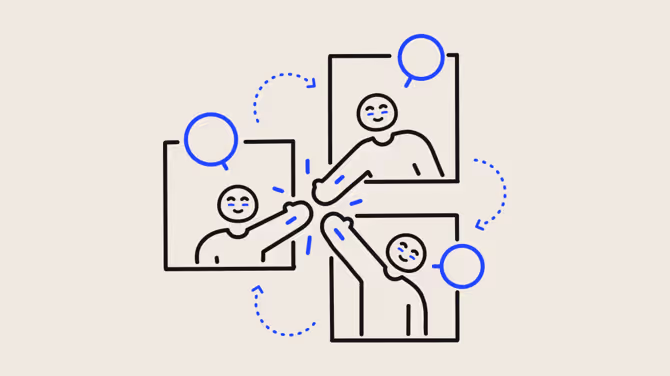How to deal with conflict in a team: 6 proven strategies

Discover Workleap Officevibe's benchmark report on 12 key employee engagement metrics

No team is immune to workplace conflict. And if you treat a seemingly small clash as a non-issue, failing to acknowledge it might erode trust and kill your team’s motivation. But if you know how to manage disagreements effectively, those efforts can spark engagement and strengthen team members’ relationships.
That’s why learning how to deal with conflict in a team is essential for managers. Let’s break down proven conflict resolution tips and strategies for resolving workplace disagreements before they derail your team’s momentum.
What’s conflict management in a workplace?
Resolving conflict at work means actively addressing disagreements and misunderstandings between team members. To keep people connected and productive, managers need to have the skills to help employees find acceptable solutions to problems.
Conflicts emerge in teams for a few reasons:
- Communication differences: A mismatch in communication styles or a lack of information can create misunderstandings and strain team members’ relationships. This is especially true in cross-functional teams, where different departments bring their own processes and priorities.
- Unreasonable deadlines: Unrealistic timelines can lead to stress and even resentment, which often bubble up into conflicts.
- Unclear performance standards: Unclear standards are a silent killer that can cause frustration, feed conflict, and lower employee engagement. Make team members aware that you’re measuring their work so they understand the metrics of success.
- Unclear expectations: Ambiguous roles, poor employee feedback, or a toxic company culture can lead to missed priorities and unnecessary disagreements.
When leaders step in confidently, they set the tone for conflict management and cultivate safety for their team. Managers who actively mediate conflict see more resolutions, healthier team dynamics, and lower turnover rates, all of which keep teams aligned and thriving.
Types of conflict resolution in the workplace
Before you can resolve conflict in a team, you need to know what you’re dealing with. Most disagreements fall into one of four categories, and understanding each type makes it easier to respond effectively to your team.
Relationship conflict
In diverse workplaces, relationship conflict often results from personalities that don’t click or past interactions that have bled into the present. Even though this type of conflict isn’t limited to the workplace, it can chip away at performance if you let it fester. The sooner the manager can step in to create a focus on common ground, the better.
Task conflict
No two people will perform a task in the same way, and that’s a good thing. But some team members might see those differences as a lack of respect for the other’s work. Managing this type of conflict correctly can actually spark creativity and lead to better ideas.
Status conflict
This one pops up when team members compete for influence, recognition, or decision-making power. Ignoring status conflict could lead to resentment and even turf battles that poison collaboration. You can defuse this type of workplace conflict by refocusing teams on shared goals and making everyone’s roles crystal clear.
Process conflict
“Process” refers to how work gets done — who does what, when, and what steps are taken to get there. Process conflict often results from unclear expectations or mismatched workflows. Clear processes and defined roles can prevent and resolve this type of workplace conflict and avoid letting it slow your team’s progress.
How to resolve conflict in the workplace: 6 strategies that work
Once you know what’s causing the tension, the next step is addressing it. Try one of these six conflict management strategies.
1. Get to the root cause
Resist quick fixes. Dig into the root cause of the issue to manage conflict before it gets bigger. This approach aligns with emerging insights on conflict-intelligent leadership, which encourages understanding the context of workplace disagreements and individual personalities to build trust.
2. Talk to team members one-on-one
Instead of hosting a teamwide meeting to address workplace conflict, which can lead to defensiveness, schedule one-on-one meetings. Employees tend to speak more openly and feel more heard in a quieter setting, which boosts communication and, in turn, conflict resolution.
3. Find solutions together
Once you’ve heard about the situation from all sides, gather everyone involved to work on the next steps. This isn’t about rehashing the conflict but rather moving forward together. Set ground rules to focus on the issue at hand so you can work toward productive and fair conflict resolution.
4. Create a conflict resolution plan
After the group agrees on how to move forward, turn that agreement into action by asking who will do what and when. Document these steps so every team member sees their role in conflict resolution.
5. Follow up
Conflict resolution in the workplace doesn’t stop at “case closed.” Follow up with your team members individually. Touch base to ask how they’re feeling, discuss their concerns, and offer support to keep internal communication open and catch any misfires early.
6. Document the workplace conflict
Keep a record of what happened, who was involved, and how you resolved it. Good documentation offers important clarity for managers and team members and helps you measure how well you’re resolving workplace conflicts over time.
Conflict management techniques for in-person and remote teams
If you want to stop workplace conflict before it starts, start building these habits:
- Develop your team’s conflict resolution skills: When people know how to resolve conflict on their own, minor disagreements stay minor. Training everyone (not just managers) builds a shared vocabulary and helps keep small issues from escalating.
- Help your team communicate better: Clarity kills confusion, so encourage transparent communication and active listening. Teams that speak empathetically to one another and paraphrase what others are saying to confirm they understand can collaborate more smoothly.
- Build positive workplace relationships: When team members feel seen, respected, and valued, they’re less likely to fall into conflict.
- Try team-building activities: With a bit of intentional planning, team-building activities become fun ways to help employees connect instead of just icebreakers. Scavenger hunts, karaoke, and escape rooms are all fun ideas for remote or in-person teams.
- Keep open communication channels: Create regular spaces for employees to share what’s on their mind, whether through 1:1s, team check-ins, or anonymous surveys in Workleap Officevibe. These insights give managers valuable context to address tensions early and handle conflicts with more clarity..
- Make the most of feedback tools: Workleap Officevibe gives team members safe, anonymous ways to share concerns and feedback directly with managers. Paired with pulse surveys, these tools surface communication gaps early, allowing you to step in before small issues turn into bigger conflicts.
Conflict resolution for fully remote teams
Managing conflict without face-to-face interaction can be a bit more of a challenge. Virtual friction can sneak up on teams, but a few proactive habits go a long way toward maintaining peace:
- Avoid using email to resolve tension: When you send a digital message, the recipient misses out on little nuances like your tone and facial cues. Choose real-time avenues like video calls to resolve conflict instead.
- Provide tech support for remote employees: Tool-related friction makes effective communication harder, which can spark disagreements. Good tech support helps these workers stay engaged and productive.
- Make sure team members’ schedules are transparent: Unclear schedules often lead to conflict and frustration. Transparent scheduling keeps the work environment cohesive and avoids missed connections.
- Trust your employees: Micromanaging employees in hybrid and remote settings tends to damage morale and drive workplace conflict. Managers who trust their teams build an open, resilient culture.
- Coach remote workers: Coaching matters, even if the mentor and mentee are thousands of miles apart. Connect with remote workers regularly to model empathy and teach practical conflict resolution skills.
- Keep the end goal in mind: At its core, conflict management is about your team’s goals and connection — not just calming tension. Whether you’re resolving workplace conflicts through conversation or preventing them entirely, always make better communication and alignment the goal you’re working toward.
Change the way you deal with conflict at work with Workleap Officevibe
Workplace conflict isn’t all bad. It’s often just a sign your team cares enough to speak up. Leaders who lean into conflict instead of ignoring it build better communication and stronger relationships. The key is to address issues early, encourage open dialogue, and focus on shared goals.
Workplace Officevibe can help you turn workplace conflict from a productivity drain into growth. Pulse surveys, anonymous feedback, and recognition tools give managers insight into how their team is feeling, which prevents small concerns from getting out of control. Officevibe also integrates with the communication tools your team already uses to keep conversations flowing and projects on track.
Try Workleap Officevibe for free to create a work environment grounded in transparency and trust.
Give HR and managers the clarity, confidence, and connection to lead better every day.


%20(1).avif)


.avif)
.avif)

%20(1).avif)






